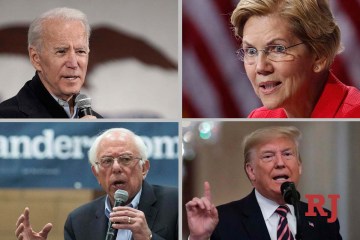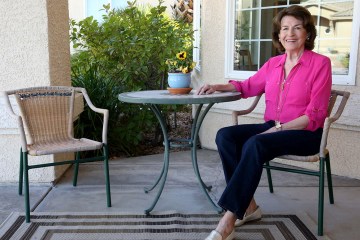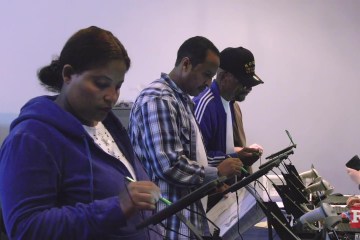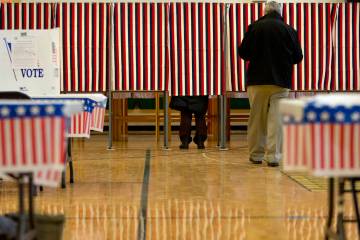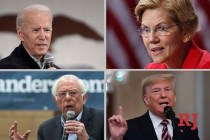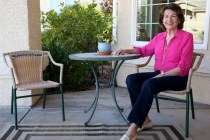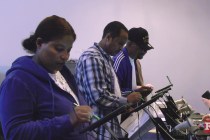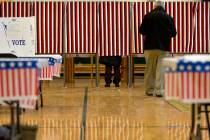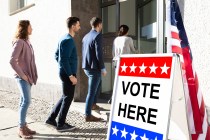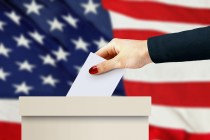Nonpartisan voters may hold the key to Nevada 2020
Republicans and Democrats get all the headlines. They bring in the money, and they control all partisan elected offices in Nevada.
But the true power to decide future state elections, as well as whether Nevada again breaks for a Democratic presidential candidate or sides with President Donald Trump in 2020, may rest with a growing amorphous blob vaguely resembling a voter bloc: nonpartisans.
The nonpartisan voter designation has grown in Nevada by 89 percent in the last decade, while Republican and Democratic registrations grew by 24 and 15 percent, respectively. Nonpartisans now make up more than 22 percent of the active electorate, compared with Republicans at 33 percent and Democrats at 38 percent.
According to one Nevada political scientist, nonpartisan voters could surpass Republicans in the next decade. Another says fewer than 5 percent are truly nonpartisan — most maintain partisan leanings and vote accordingly.
Nonpartisan voters are, on average, younger than Republicans and Democrats, a Las Vegas Review-Journal analysis of state voter registrations found. Nearly half are younger than 40, compared with 36 percent of Democrats and 26 percent of Republicans.
They also appear to vote less frequently. Those who were eligible to vote in both the 2016 and 2018 elections did so at a lower rate than Republicans and Democrats.
The numbers may be straightforward, but getting inside these numbers — forming messages that appeal to voters turned off by party branding, and predicting how or if they will vote — is another matter. And academics, political operatives and those working behind the scenes for the parties have different ideas for how to get there.
“We’ve seen the rise of independent voters in Nevada who aren’t into the rough and tumble or how nasty politics is,” said Jeremy Gelman, an assistant professor at the University of Nevada, Reno who studies how partisanship affects congressional agenda-setting.
“They’ll tell you they’re proudly independent, but that’s a social reaction to their dissatisfaction (with politics),” he added. “They think this makes them look more rational, that they’re considering issues more deeply before making a choice. But when you ask them questions — How did you feel on election night in 2016? — you find that independents are not ideologically different than Democrats or Republicans.”
Identity questions
Billy Vassiliadis is one of Las Vegas’ best-known campaign advisers, having counseled the last two Democratic presidents, former Senate Majority Leader Harry Reid and dozens of local candidates.
Historically, he said, independent voters were more moderate. But the ranks are now swelling with those who are dissatisfied with partisan politics.
Because both Republicans and Democrats require a rigid litmus test on many national issues, Vassiliadis said, some voters are taking an “a la carte” approach to picking individual policy positions rather than accepting an ironclad set of ideals.
“If a Republican wants gun control, they are snapped back in line,” he said. “If a Democrat wants more moderate health care, they get attacked from the left.”
Younger voters, Vassiliadis added, do not have the same party loyalty as their parents. They customize their relationships through technology, receiving alerts for the news and messages they want and ignoring the rest. Traditionally rooted parties don’t have that flexibility.
Geography also plays a role, Vassiliadis said.
“Nevada, Arizona, Colorado, Utah — these are transient states,” he said. “They don’t have many third- or- fourth-generation party members. People make a practical decision to move here. They come for that good-paying job or their education. They care about the kitchen table issues: school safety and quality. Is the copay for my sick kid $500? Are my taxes going to go up?”
Vassiliadis believes parties can reach nonpartisans by focusing on these issues rather than the “giant philosophical debates going on in national politics.”
Gelman agrees that tailoring an appeal to “closet Democrats or Republicans” is an essential strategy, as nonpartisans may very well be the deciding factor in the 2020 presidential election. Democrats in Nevada and throughout the country captured House seats in 2018 with many assists from nonpartisans, but that doesn’t mean Republicans won’t grab independent voters in a Trump year.
“It’s a popular misconception that independents vote as a bloc, and this is swinging elections,” he said. “Closet Democrats turned out (in 2018), but independents who lean Republican probably didn’t.”
Choosing a side
Predicting trends in voter registration can be tricky, but Gelman believes nonpartisans could surpass Republicans in Nevada within the next decade. The presidential election may play a role, he said, but dissatisfaction with state and local parties is the primary factor.
But other experts believe nonpartisan registrations could flatten out as key 2020 dates loom.
Dan Lee, an associate professor of political science at UNLV who studies third-party impacts on the two-party system, said some could end up choosing a side as the 2020 campaign heats up in the fall and winter.
Because Nevada is a closed-primary state, only registered Democrats will get to play a role in selecting a nominee from a field that could include a dozen or more candidates in February. The Nevada Republican Party will not hold a public caucus in 2020.
Lee said there could be some truth to the idea that many nonpartisans are former Republicans who left the party in protest of Trump, but he noted that many of these leaners would also be unlikely to choose a Democrat on Election Day.
True independent voters are quite rare, and such independence is usually a form of apathy or ignorance, Lee said. These voters may have no interest in politics whatsoever, he said, or they don’t understand which side stands for which policies or principles.
They should try and get the people who are leaving to stay. For the Republicans, that’s just not where they’re at. They say, ‘If you don’t adhere to us 100 percent, we don’t want you anyway.’
Eric Herzik, political science professor at UNR
Eric Herzik, a political science professor at UNR, said true independents account for only 3-5 percent of nonpartisan registrations.
Herzik believes there could be a “Trump factor” in the nonpartisan registration increase, but he said some Republicans may have left the party because it “wasn’t Republican enough.”
He cited an adage from Rep. Mark Amodei, the only Republican in Nevada’s congressional delegation: “You can never be a good enough Republican to another Republican who disagrees with you.”
Herzik said both parties, but particularly the GOP, should be worried by this mentality and the rise of nonpartisan registrations.
“They should try and get the people who are leaving to stay,” he said. “For the Republicans, that’s just not where they’re at. They say, ‘If you don’t adhere to us 100 percent, we don’t want you anyway.’ ”
The Republican strategy of appealing to a smaller base with a high voter turnout rate gives the party a ceiling, Herzik said, as evidenced by the last midterm election.
In 2014, Democrats “wrote down the wrong day in their calendars,” he said. Four years later, both parties increased turnout, but Democrats “did a better job” and won sweeping victories across the ballot.
Regardless of voter preferences and party strategies, Nevada’s voter registration numbers will look radically different for the 2020 election. Automatic voter registration, approved by Nevadans as Question 5 in 2018, is scheduled to begin in January.
Wayne Thorley, the state’s deputy secretary of state for elections, said residents will be given a separate form upon completing in-person appointments at Nevada Department of Motor Vehicles locations.
The form will allow drivers to choose their party, as the current optional form does, or opt out of the registration. However, anyone who does not fill out and turn in the form will be automatically registered as nonpartisan.
They’ll tell you they’re proudly independent, but that’s a social reaction to their dissatisfaction (with politics). They think this makes them look more rational, that they’re considering issues more deeply before making a choice. But when you ask them questions — How did you feel on election night in 2016? — you find that independents are not ideologically different than Democrats or Republicans.
Jeremy Gelman, assistant professor at the University of Nevada, Reno
Trump scoring voters
Both state parties say they are tracking voters who switch either in or out of the party on a month-to-month basis, but the Republicans are taking it one step further — rating voters.
“Every voter has a score, from Adam Laxalt to Steve Sisolak,” said Jeremy Hughes, a GOP consultant at November Inc. who is working as the Trump campaign’s regional political director for the Pacific states. Though not a state GOP employee himself this cycle, Hughes and other Trump campaign officials have taken a lead role in coordinating the state’s Republican strategy.
The scores have been generated over the last five years through a variety of testing points. Each voter profile begins with between 3,000 and 4,000 commercially available data points. Surveys, polls and other data collected by local, state and national parties are fed into an algorithm maintained by GOP analysts that spits out several scores. Those one-question surveys that pop up after videos on YouTube or as sponsored posts on Facebook, for example, feed into a person’s score.
Republican National Committee spokeswoman Christiana Purves said these numbers can help predict two crucial factors: Which voters are most likely to turn out, and which ones are the most likely to vote Republican?
Another score, deemed a Trump score, rates how a voter aligns with the Republicans on the issues.
Though the state GOP is often cagey about releasing actual numbers during a campaign cycle, Hughes said the system has already identified more than 100,000 “disengagers” — those with high Trump scores who turned out in 2016 but did not vote in 2018 — just in Nevada. Many of these voters are registered as nonpartisan, he said.
The party tailors messages specific to that large group. For example, many score favorably in a common GOP survey question: Do you believe the Congress should work with the president, or should it continue to obstruct him? Much of the party’s messaging against Reps. Steven Horsford and Susie Lee, who both represent vulnerable Democratic districts in Nevada, has centered on an attempt to paint them as obstructionists.
Purves said many “disengagers” and other nonpartisans do not favor the House impeachment inquiry.
Hughes agrees that many have gone the nonpartisan route due to constant partisan bickering, but he believes this sentiment also led to Trump’s election.
He also dismissed the notion fanned by state Democrats that canceling its caucus will hurt the state GOP’s image with voters or its ability to engage them on caucus day.
“Caucus goers are voters,” Hughes said. “There’s no loss of engagement, and the result is already a foregone conclusion.”
He added that the state GOP will save time and money that can be used to better position the president to win Nevada.
A Democratic foundation
For the Nevada Democratic Party, growing its lead in the raw numbers game through increased voter registrations is key.
“Our No. 1 core value is to expand access to the ballot box,” said party executive director Alana Mounce.
The Democrats have pushed hard to increase registrations over the last few years to build a steady foundation for whoever the 2020 nominee is. In August, for example, the party increased its registration advantage by 5,300 voters, Mounce said.
Part of this approach includes recruiting unregistered voters through text messages — a preferred means of communication for many younger Americans.
Mounce said Democrats are aiming to increase voter participation even if some of the new registrants choose not to join the party. However, due to the closed caucus system, there is some specific outreach to try and recruit nonpartisans into the party.
She said nonpartisans “voted in overwhelming numbers for our candidates in 2018,” adding that CNN exit polls showed 57 percent of nonpartisans voted for Sen. Jacky Rosen and 55 percent went for Gov. Steve Sisolak — the two Democrats at the top of the ballot, who both captured positions previously held by Republicans. Rosen was the only Democrat to defeat a Republican incumbent U.S. senator, Dean Heller.
While Democrats are working daily to increase voter participation, Mounce said, the Republicans are closing doors by not holding a caucus. Apart from the ability to recruit volunteers and organizers during the caucus, the Democrats registered 30,000 new voters on caucus day in 2008 and 14,000 in 2016.
Meanwhile, she said, Republicans are “on a path to becoming the third party in Clark County.”
Contact Rory Appleton at RAppleton@reviewjournal.com or 702-383-0276. Follow @RoryDoesPhonics on Twitter.
Our political team is looking for active, registered nonpartisan voters interested in sharing their opinions on the 2020 elections. If you would like to participate in upcoming panels, please email us at themiddle@reviewjournal.com or contact us using the form below:



